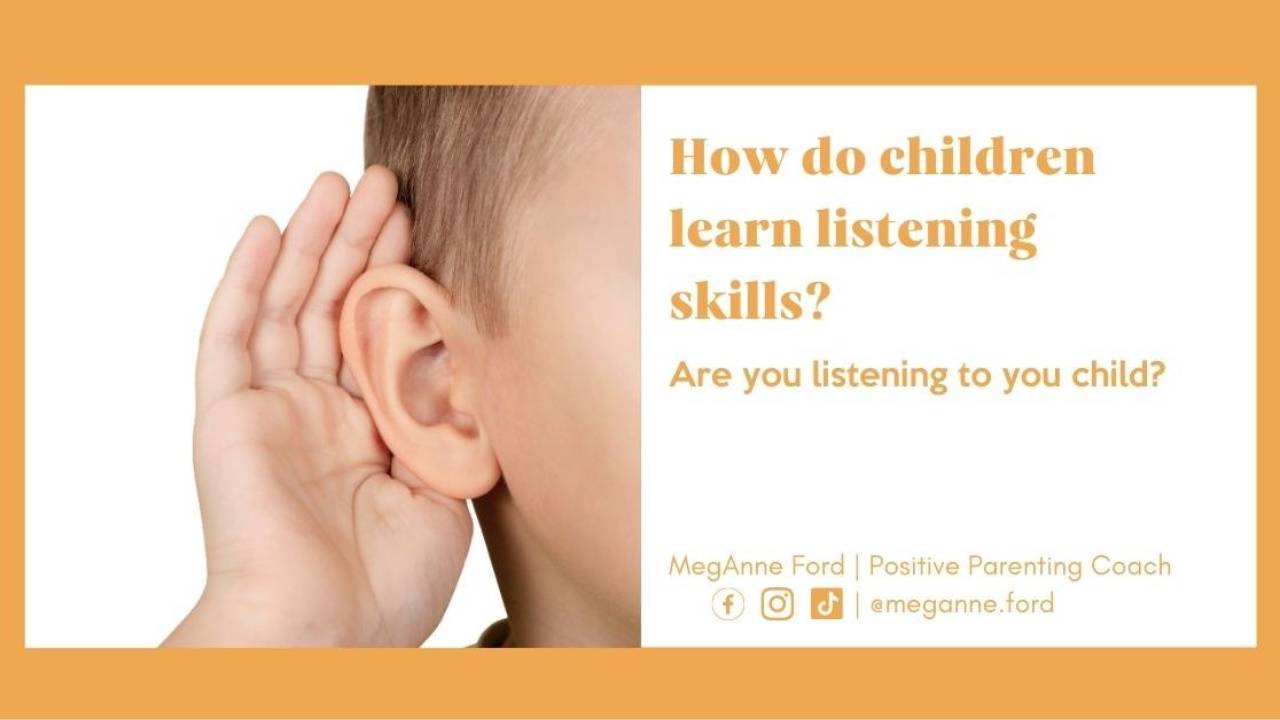
How to get Kindergarteners to Listen?
Jun 17, 2024
Asking “How to get kindergarteners to listen" is the same as asking for a 2-year-old, 6-year-old, or any age. Active listening is a foundational tool for a positive parent. Listening actively can improve all of your relationships, especially with your children.
I often hear:
- "They are not listening."
- "They think they are the boss."
- "How do I get them to listen to me the first time?"
- "How do I get them to react calmly when they don’t get their way?"
If you identify with these sentiments or have even heard yourself or someone else saying these things, I want you to know that this blog is for you. Today, we're going to explore how listening is a skill best taught through modeling. We learn to listen from being listened to.
It's common that “they” say, “they just need to listen to their parent the first time.” I say, “They are listening exactly how you model listening.” Children who listen have parents who listen, and we often listen similarly.
What are types of Listening?
Let's ground our discussion with learning what listening is. Listening is the second part of communication. Often we think the verbal or the passing of information to someone, listening, and comprehension are the back half. To have clear and effective communication, the talking and the listening must work in flow.
The act of listening involves complex, effective cognitive and behavioral processes. To have an effective listening process, you must have the motivation to listen. The cognitive process is the ability to have the attention to listen, and behavioral is those verbal and non-verbal feedback cues.
How to get your 4-year-old to listen
Start thinking of it as a polite tennis practice.
When I think of effective listening and communication, I think about tennis. We are imagining a practice where you are just working on passing the ball between players.
Imagine, during this polite game, you went to serve, and your opponent just stood there or even left. Your opponent just didn’t have the motivation to play with you. We can agree this is not a very effective way to play tennis.
Now imagine that each of you was serving the ball simultaneously, or your opponent, out of the blue, hit the ball so it would hit you on purpose! That would feel very chaotic, overwhelming, and confusing. The flow of the game would be broken.
Finally, let's picture you hit the ball over, and someone hit it back, and you could hit it back and forth to each other comfortably. That would be exciting and motivate you to continue the game and return.
Using tennis practice as a visual for communication allows us to see the potential for a fluid game of back and forth where we share the same goal. We share the same methods, and we're both there to have the same goal of working together and listening.
This is the opposite of obeying. When we say things like “They’re not listening to me!” what we are really saying is, “I want them to follow my commands without pushback.”
Listening as an action
Roland Barthes is a French linguist. He describes listening as:
“It is the interpretative action taken by someone in order to understand, and potentially make sense of, something one hears” - Roland Barthes
He then explains that listening can be understood on three different levels.
- Alerting - Detection of noise
- Deciphering - Detecting patterns and interpreting those patterns
- Understanding - comprehension of the pattern and appropriate interpretation.
This was is a new concept for me. Listening to someone first means that we have to be able to be alerted to it. This means we must detect the noise, the words, and the sound. Then, we move into the impact of the sounds and how we decipher and interpret those patterns.
Hearing someone talk to us, we can decipher what those words and tones mean. Then, we can interpret those patterns of words. The third aspect is understanding, which is the comprehension of those patterns of words and having an appropriate interpretation.
I think having an appropriate interpretation is a powerful process.
self-assessment scale of 1-10:
How well do you listen to your children?
- Are you motivated to listen to them?
- Are you paying attention to what they are sharing with you?
- Are you showing verbal and non-verbal cues that you hear them?
A little deeper now
- Are there times that it is easier and harder for you to listen to them?
- Are there times of the day when you have more space, bandwidth, and availability to listen to them?
- Are there times of the day when you're more distracted, don't have the space, and cannot give them that space?
We can now take that acknowledgment and self-assessment of ourselves and think about those questions through our child's lens:
- Are there times easier and harder for your children to listen to you?
- Are there times of that day, their moods, or ways of communicating that you know work better for your children and work better for you so that you have the same understanding and comprehension together?
The goal is to start playing that tennis game in flow with each other.
What are the types of listening?
We will break down four different types of listening: informational, biased, defensive, and active.
Informational listening
You are doing informational listening right now. Informational listening is consent-based. It means you feel safe and actively learn about a topic you're interested in. It requires a high concentration level and engages your critical thinking. The goal of informational listening is to acquire knowledge.
You use this type of listening when listening to audiobooks, podcasts, or in class. When your child is listening in school, watching a game, or talking with their friends, and their friends are teaching them something, this requires more space to receive the information and then give space to process it.
I really want to stress it's consent-based, and it's having an interest in something. The person acts as an empty vessel into which the person can pour.
Often, the dark side of informational listening can lean toward lecturing. We expect the other person to be informational listening, but maybe they're not interested in what we're talking about. They can't hear the concepts we're trying to communicate to them. They're not able to understand what we're speaking to.
Biased listening
Also called selective listening, biased listening is when you only select the things you want to hear someone saying. I hear this from parents: “My children have their selective listening ears on.” This means they are pruning out what they deem to be unneeded information. There is an intention of getting specific information but not wanting to understand. The end goal here is to listen to respond to the aspects that you deem important.
An example is when you are in a work meeting with all the different departments that need to run through what is important to them. You chose to tune out a little bit. Maybe you are checking your phone. You're just waiting for them to call your department.
When we practice this kind of listening, we need to be aware that we might miss out on details that could add context to the topic we care about. We can sometimes show up invalidating someone if we do not actively listen to the whole situation.
Defensive Listening
Defensive listening is where we are literally activated into our defenses. We engage those defenses because we are triggered into our fight, flight, freeze, and faun response. When this happens, we may misinterpret comments. We may be listening to comment back to defend ourselves, to give our side of the story. We also might start using globalization, like “they never do this,” “always do this,” “I never get to,” or “always have to.” The goal of defensive listening is to defend ourselves.
An example is if you're sitting down to dinner and you've made something:
-The child says: “I hate this dinner.”
-parent says: “Well, you ate this dinner just last week, and you loved it. I guess I'll just never make it again.”
We take what has been told to us, what has been communicated to us, and then we misinterpret it, miss out on cues, globalize it, and take it personally instead of having that time to truly have the other person feel heard.
We can reconnect the idea of the tennis practice; they are hitting the tennis ball, and we are hitting back a volleyball. ”Whoa, that's not even what I was saying,” but that's how they're communicating back to us. That's a form of miscommunication. It's a communication breakdown.
Active Listening
The most effective is active listening. It requires the listener to stay present to what is being said, without judgment, to reflect on what they hear, and to ask for clarity. The goal is listening to understand the other person. Often this is hard to do. It's quite easy to jump into defensive or biased listening. It takes a lot of effort and bandwidth to stay present and out of judgment. Here, I would like to remind you that what is hard is unpracticed.
Just like the game of tennis, we need to practice the flow of the game to improve.
Take the example of dinner again:
-child says: “I hate this dinner”
-parent says: “Sounds like you're not happy about this dinner. Is there anything we can do to make it better”
We are actively listening to what the other person is feeling, allowing them space to feel understood. We are not taking what they say personally, not globalizing it, not trying to rationalize or defend it, just trying to seek understanding and clarity.
I want to emphasize that active listening takes practice and requires a belief that mistakes are opportunities to learn. If you start practicing active listening, I recommend finding a safe place to learn. Is it at the dinner table? Getting ready for school? Getting in the car? Where are you not getting triggered into the lower brain and can practice slowing down and actively listening to understand?
This is all modeling to the children so they reflect our active listening.
Reflecting on the question, “How to get Kindergarteners to Listen?”
Consider which type of listening comes most easily for you with different people in your life.
I know that when I'm around some family members, I shift into defensive postures quite easily. I know that it's a lot easier for me to listen actively and empathetically to my husband or friends. Those are people who feel safe to me.
What type of listening is your child reflecting you?
They are picking up what we're putting down. How can we build new skills if they use the less-than-desired listening type? How can we start to slow down and practice new skills together?
Children who listen have parents who listen.
What would help you become a more confident, active listener with the people who challenge you?
Even I hate that question above. There's always space to listen to someone who disagrees with you. Listen and seek clarity and understanding from someone who holds a differing opinion. Those times are where the most growth happens.
How can we hold the space for people we disagree with, and what transformation can happen if the other person feels heard and understood?
Where can you practice listening in play? Roughhousing would be a great way to practice listening tools.












